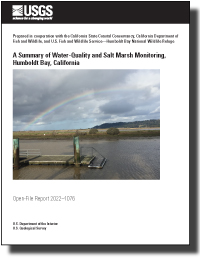A Summary of Water-Quality and Salt Marsh Monitoring, Humboldt Bay, California
Links
- Document: Report (12 MB pdf) , HTML , XML
- Data Releases:
- Model archive summary for a suspended-sediment concentration surrogate regression model for station 404038124131801; Hookton Slough near Loleta, CA
- Model archive summary for a suspended-sediment concentration surrogate regression model for station 405219124085601; Mad River Slough near Arcata, CA
- Salt marsh monitoring during water years 2013 to 2019, Humboldt Bay, CA—Water levels, surface deposition, elevation change, and soil carbon storage
- Download citation as: RIS | Dublin Core
Abstract
This report summarizes data-collection activities associated with the U.S. Geological Survey Humboldt Bay Water-Quality and Salt Marsh Monitoring Project. This work was undertaken to gain a comprehensive understanding of water-quality conditions, salt marsh accretion processes, marsh-edge erosion, and soil-carbon storage in Humboldt Bay, California. Multiparameter sondes recorded water temperature, specific conductance, and turbidity at a 15-minute timestep at two U.S. Geological Survey water-quality stations: (1) Mad River Slough near Arcata, California (U.S. Geological Survey station 405219124085601) and (2) Hookton Slough near Loleta, California (U.S. Geological Survey station 404038124131801). At each station, discrete water samples were collected to develop surrogate regression models that were used to compute a continuous time series of suspended-sediment concentration from continuously measured turbidity. Data loggers recorded water depth at a 6-minute timestep in the primary tidal channels (Mad River Slough and Hookton Slough) in two adjacent marshes (Mad River marsh and Hookton marsh). The marsh monitoring network included five study marshes. Three marshes (Mad River, Manila, and Jacoby) are in the northern embayment of Humboldt Bay and two marshes (White and Hookton) are in the southern embayment. Surface deposition and elevation change were measured using deep rod surface elevation tables and feldspar marker horizons. Sediment characteristics and soil-carbon storage were measured using a total of 10 shallow cores, distributed across 5 study marshes, collected using an Eijkelkamp peat sampler. Rates of marsh edge erosion (2010–19) were quantified in four marshes (Mad River, Manila, Jacoby, and White) by estimating changes in the areal extent of the vegetated marsh plain using repeat aerial imagery and light detection and ranging (LiDAR)-derived elevation data. During the monitoring period (2016–19), the mean suspended-sediment concentration computed for Hookton Slough (50±20 milligrams per liter [mg/L]) was higher than Mad River Slough (18±7 mg/L). Uncertainty in mean suspended-sediment concentration values is reported using a 90-percent confidence interval. Across the five study marshes, elevation change (+1.8±0.6 millimeters per year [mm/yr]) and surface deposition (+2.5±0.5 mm/yr) were lower than published values of local sea-level rise (4.9±0.8 mm/yr), and mean carbon density was 0.029±0.005 grams of carbon per cubic centimeter. From 2010 to 2019, marsh edge erosion and soil carbon loss were greatest in low-elevation marshes with the marsh edge characterized by a gentle transition from mudflat to vegetated marsh (herein, ramped edge morphology) and larger wind-wave exposure. Jacoby Creek marsh experienced the greatest edge erosion. In total, marsh edge erosion was responsible for 62.3 metric tons of estuarine soil carbon storage loss across four study marshes. Salt marshes are an important component of coastal carbon, which is frequently referred to as “blue carbon.” The monitoring data presented in this report provide fundamental information needed to manage blue carbon stocks, assess marsh vulnerability, inform sea-level rise adaptation planning, and build coastal resiliency to climate change.
Suggested Citation
Curtis, J.A., Thorne, K.M., Freeman, C.M., Buffington, K.J., and Drexler, J.Z., 2022, A summary of water-quality and salt marsh monitoring, Humboldt Bay, California: U.S. Geological Survey Open-File Report 2022–1076, 30 p., https://doi.org/10.3133/ofr20221076.
ISSN: 2331-1258 (online)
Study Area
Table of Contents
- Acknowledgements
- Abstract
- Introduction
- Methods
- Results and Discussion
- Summary
- References Cited
| Publication type | Report |
|---|---|
| Publication Subtype | USGS Numbered Series |
| Title | A summary of water-quality and salt marsh monitoring, Humboldt Bay, California |
| Series title | Open-File Report |
| Series number | 2022-1076 |
| DOI | 10.3133/ofr20221076 |
| Year Published | 2022 |
| Language | English |
| Publisher | U.S. Geological Survey |
| Publisher location | Reston, VA |
| Contributing office(s) | California Water Science Center, Western Ecological Research Center |
| Description | Report: viii, 30 p.; 3 Data Releases |
| Country | United States |
| State | California |
| Other Geospatial | Humboldt Bay |
| Online Only (Y/N) | Y |
| Additional Online Files (Y/N) | Y |
| Google Analytic Metrics | Metrics page |


